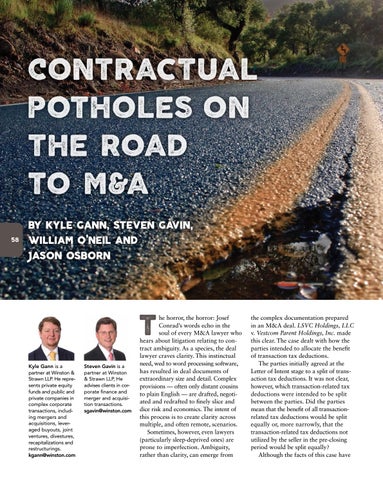COntractual pOthOles On the rOad tO m&a 58
by kyle gann, steven gavin, william O’neil and JasOn OsbOrn
Kyle Gann is a partner at Winston & Strawn LLP. He represents private equity funds and public and private companies in complex corporate transactions, including mergers and acquisitions, leveraged buyouts, joint ventures, divestures, recapitalizations and restructurings. kgann@winston.com
Steven Gavin is a partner at Winston & Strawn LLP, He advises clients in corporate finance and merger and acquisition transactions. sgavin@winston.com
he horror, the horror: Josef Conrad’s words echo in the soul of every M&A lawyer who hears about litigation relating to contract ambiguity. As a species, the deal lawyer craves clarity. This instinctual need, wed to word processing software, has resulted in deal documents of extraordinary size and detail. Complex provisions — often only distant cousins to plain English — are drafted, negotiated and redrafted to finely slice and dice risk and economics. The intent of this process is to create clarity across multiple, and often remote, scenarios. Sometimes, however, even lawyers (particularly sleep-deprived ones) are prone to imperfection. Ambiguity, rather than clarity, can emerge from
the complex documentation prepared in an M&A deal. LSVC Holdings, LLC v. Vestcom Parent Holdings, Inc. made this clear. The case dealt with how the parties intended to allocate the benefit of transaction tax deductions. The parties initially agreed at the Letter of Intent stage to a split of transaction tax deductions. It was not clear, however, which transaction-related tax deductions were intended to be split between the parties. Did the parties mean that the benefit of all transactionrelated tax deductions would be split equally or, more narrowly, that the transaction-related tax deductions not utilized by the seller in the pre-closing period would be split equally? Although the facts of this case have
